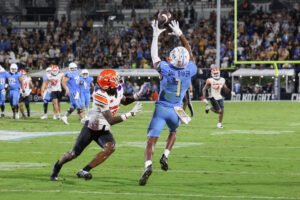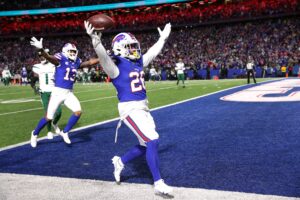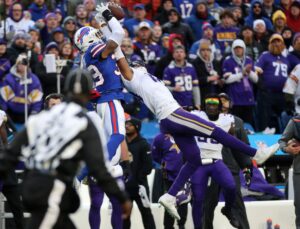A welcomed sight awaits Arizona Cardinals fans in Week 14 as veteran wide receiver Larry Fitzgerald returned to practice this week after a bout with Covid-19. Fitzgerald was reported to have tested positive Thanksgiving morning, subsequently missing losses to the New England Patriots and Los Angeles Rams. In a difficult period for the Cardinals offense–once ranked the league’s top offensive unit–the return of the wily veteran is sure to bolster the ranks as the team looks to halt the slide against the New York Giants on Sunday.
Week 13’s loss against the Rams was the latest in a poor run from the Cardinals, which has seen them slide to the outskirts of the NFC playoff picture. Although the Cardinals faced a Rams defense boasting the likes of Aaron Donald and Jalen Ramsey, it is fair to say that the offense’s issues were their own. The performance was illustrative of the issues that have plagued Arizona for the last month. Opening the game with four consecutive three-and-outs. Kyler Murray and the Cardinals had 12 of 16 plays go for zero or negative yards, showcasing the extent of the offense’s recent skid.
Whether it’s due to underperformance or underutilization, the Cardinals offense sputtered to a halt.
What’s Wrong With the Cardinals Offense?
The Arizona Cardinals offense lives and dies on the backs of its two most mercurial talents: Kyler Murray and DeAndre Hopkins. Just as production from the two shot the team into national recognition earlier in the season, the lack thereof in recent weeks has contributed to the team’s bad offensive output.
Kyler Murray
Although Murray adamantly states that he doesn’t need to run for the Cardinals to be successful, there is a clear correlation that suggests otherwise. In games where Murray carries less than five times, the team is 0-10-1. Murray’s running output has massively decreased since the Week 11 clash with the Seattle Seahawks. In that game, Murray suffered a sprained AC joint after a hit by L.J. Collier. Despite claiming to have shaken off the effect of the injury, the reduction in Murray’s carries indicates caution from Kliff Kingsbury.
What is also important to recognize is the extent to which the Cardinals run game is reliant on the quarterback. Despite poor rushing totals since his injury, Murray remains the team’s second leading rusher, behind only Kenyan Drake. In addition, Murray leads the team in yards per attempt, at 6.5 yards per attempt. Notably poor performances from the offensive line have contributed to low rushing totals recently, despite being acknowledged for their good play earlier this year.
It’s critical to note that the rushing attack is, surprisingly, an area which suffered as a result of Fitzgerald’s absence. Since Bruce Arians moved him inside, Fitzgerald has become extremely proficient as a blocking receiver on run plays.
DeAndre Hopkins
DeAndre Hopkins believes he is the best wide receiver in the game, as do many others. In the first half of the season, the stats reflected that belief as Hopkins led the league in both receiving yards and receptions. Unfortunately, the relative disappearance of the All-Pro wideout from the Cardinals strategy has translated to him slipping from the top spot in both categories.
Troubling graphics from AWS give some indication as to why. In addition to facing two of the league’s top corners, Jalen Ramsey and Stephon Gilmore, in consecutive weeks, Hopkins has been deployed on a severely-limited route tree. Running a combination of quick outs and hitch routes, it is no wonder that Hopkins hasn’t surpassed 60 yards in each of the last three games. Given that Kingsbury’s ‘Air Raid’ offense is ostensibly built on pass concepts, failing to properly utilize one of the league’s very best is concerning for the second-year head coach.
Rushing Attack:
Protecting Kyler Murray is paramount. Kliff Kingsbury has made that point perfectly clear in his game plan. Therefore, the responsibility on the ground lies with Kenyan Drake and Chase Edmonds. The offensive line has demonstrated their proficiency throughout the season. Assuming a return to form from the front five, Drake and Edmonds should be expected to shoulder more of the load.
In fact, establishing a solid conventional rushing game might open up more chances for Murray. As arguably the league’s most dynamic runner, defenses began to smarten up to Murray’s threat on option plays. Forcing defenders to make a decision, rather than being able to key on Murray, will allow the young star quarterback to exploit these situations.
The Passing Game
DeAndre Hopkins is an elite-level receiver. Drawing the top cover players is part and parcel of the lofty reputation Hopkins has garnered. The route package that Hopkins has been targeted on is indicative of the attention paid to Hopkins; quick routes free up Hopkins, but offer very little in terms of yards after catch opportunities. Often split wide left, moving Hopkins around could be instrumental in opening up his full arsenal. Similarly, attracting attention towards Hopkins could open up other areas of the field for Murray to attack.
Expanding the route tree is important not only for Hopkins, but also for the rest of the wide receiver corps. A notable absence from the Kingsbury offense so far is the slant pass. This gives some notion as to why YAC opportunities have been limited for Arizona since the slant has a high potential for such. Reworking some passing concepts could help the passing attack to flourish.
Shotgun or Under Center?
Another visual identifier of Kingsbury’s system is the frequent use of the Shotgun concept. Unfortunately, running out of this formation has been unproductive. Moving Kyler under center opens up a wealth of options in both the pass and run game. In the run game, the shallower depth at which the running back receives the handoff would help to eliminate the kind of negative plays seen against the Rams.
Another option is for Kingsbury to employ elements of the West Coast offense, usually under center, such as the slant pass. Getting the ball out quickly lessens the chance for negative yardage plays as well as offering the chance for more YAC production. The return of Fitzgerald could influence this decision, as the veteran’s large frame and route-running experience makes him well suited for passes over the middle of the field.
Taking yet another cue from Sean McVay and the Rams, the under-center approach also offers an option of the play-action rollout. Whilst reliant on a consistent running game, the rollout could open up the field for bigger plays. Getting Murray outside also allows Kingsbury to effectively utilize his quarterback’s stunning athleticism.
With the regular season coming to a close, getting the offensive woes corrected will greatly boost the Cardinals chances in clinching a spot in the playoffs.
Main Photo:
Embed from Getty Images






